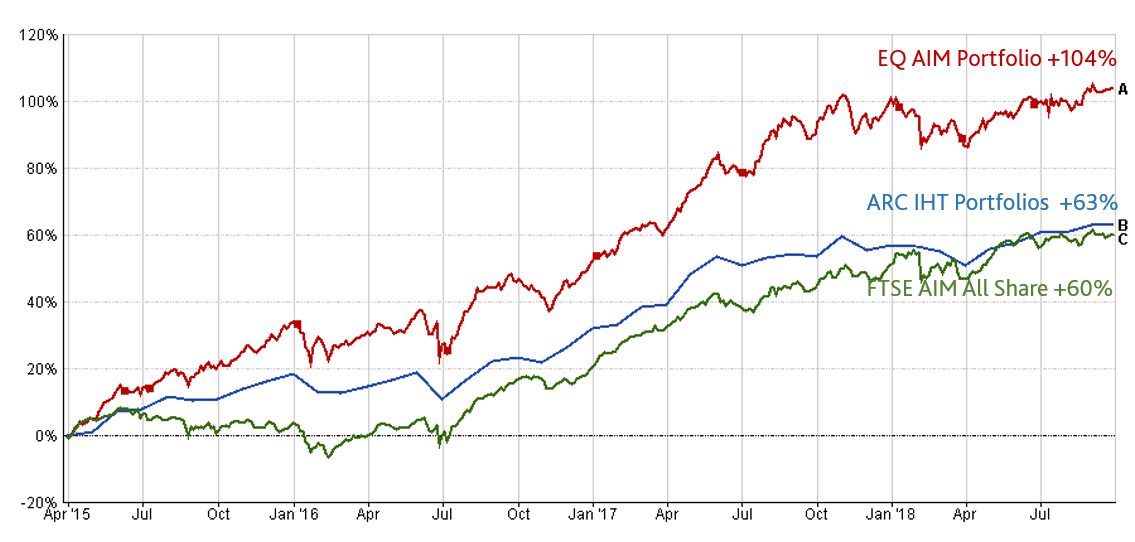Market Update – The EQ AIM Portfolio and recent market volatility

Neal Foundly, Investment Analyst, Equilibrium Investment Management
The EQ AIM Portfolio and recent market volatility
2018 proved to be turbulent year for most stocks and shares around the globe. The rise in interest rates in the US and concerns over trade wars and Brexit in the UK led to marked weakness in ‘growth stocks’ in particular – those valued for a rapid rise in future earnings.
As a consequence, the FTSE Alternative Investment Market (AIM) Index, which is full of small growth stocks, fell (in total return terms) by 17.1% for the 12 months compared to the broader FTSE All Share Index return which declined by 9.5%. Another illustration of the de-rating of growth stocks was the performance of the FTSE Software & Computer Services sector which saw a loss of 25.4% over the year.
Targeted at tax
In terms of the Equilibrium AIM Portfolio, our performance was a little lower than the AIM index but, to a degree, this is not the over-riding consideration. The primary driver of the Portfolio is to provide an investment that will allow our clients to mitigate their potential Inheritance Tax liability on death.
The Portfolio does not purport to be a high-performance investment but rather a useful vehicle for tax management. The benchmark is given as the FTSE AIM Index, not, for example, Index plus 3%, which would imply a greater focus on superior performance.
The performances of the FTSE 100 or FTSE All Share indices are not directly comparable given these stocks do not qualify for Business Property Relief (BPR). It also needs to be remembered that large parts of the AIM Index do not qualify for BPR so even this is not a perfect comparator.
Finding a suitable benchmark is not easy. However, performance measurement company Asset Risk Consultants (ARC) does produce an index of 10 AIM portfolios which, like ours, are targeted at BPR. The contributors include large providers such as Brooks Macdonald, Cazenove, Close Brothers and Investec. So whilst not a broad peer group in terms of numbers, this does offer a useful guide.
Due to the delays in collating the data, the ARC figures are only available to the end of September 2018 but Chart One shows the performance of the Equilibrium AIM Portfolio in comparison to the ARC peer group and the FTSE AIM Index since its inception in March 2015:-
Chart One: Equilibrium AIM Portfolio performance versus ARC IHT Portfolios and FTSE AIM All Share

Source: Financial Express Analytics
Relief with risks
Although the Portfolio is not targeted at high performance does not mean that we disregard returns, however.
Clearly, we work hard to identify stocks that potentially qualify for BPR but also have good potential returns within limitations of risks. The aim is to provide a broadly diversified portfolio of around 30 stocks that are involved in cash generative businesses that have a good mix of operations.
Even in the fourth quarter of 2018, when the AIM index declined by 21.5%, the Portfolio had two stocks that went up.
Over time these can stocks deliver returns but this is a high growth portfolio with shares that will be volatile at times.
The government’s original idea behind BPR was to encourage investment in small early-stage companies and it should always be remembered that the Equilibrium AIM Portfolio is a sub-set of the FTSE AIM Index, essentially consisting of young growth companies that will have volatile share prices.
Riding the rollercoaster
Of course, we are mindful of bear markets and potential impact a recession may have. However, we do not believe that this is the end of the current economic cycle – indeed, in our main investment portfolios we have been increasing the exposure to equities during recent market weakness.
In terms of the companies held in the Equilibrium AIM Portfolio, none of these companies have announced downgrades or even disappointing trading updates in the last couple of months; most have indicated confidence in the future.
Indeed, since year-end four more companies, including biotech supplies company Abcam and fizzy drinks company Nichols, have reaffirmed that profits will be as the market expects.
Sometimes share prices simply detach from fundamental value.
The trick is not to fall into the market’s trap and crystallise a loss but rather hold tight (or even better, take advantage of the weakness and buy into the lower prices).
To qualify for BPR, the investor needs to hold the shares for a minimum of two years and we deliberately design the Portfolio for the buy-and-hold investor who is keen to take advantage of the potential tax relief available.
Disclaimer: The content provided in this update represents the opinions of Equilibrium Investment Management. The value of your investments can fall as well as rise and are not guaranteed, any past performance quoted is not an indicator of future performance. Investors may not get back the amount originally invested. The commentary in this update in no way constitutes a solicitation of investment advice. It should not be relied upon in making investment decisions and is intended solely for the entertainment of the reader returns quoted are gross, before fees and charges, unless stated otherwise.
